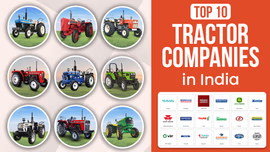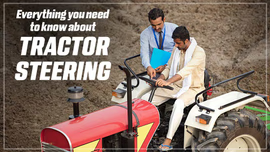A Comprehensive Guide on Puddling in Rice Farming:

Table of Contents
- What is Puddling in Agriculture?
- Why Puddling is important in Rice Farming?
- Step-by-Step Process of Puddling
- Methods of Puddling in India
What is Puddling in Agriculture?
Puddling is the most important tillage practice done in paddy fields in which soil is ploughed by a puddler in standing water of 5-10 cm depth after the initial ploughing to churn and soften the soil to prepare a soft seedbed for the cultivation of rice.
Why Puddling is important in Rice Farming?
Rice crops require a good puddle field with adequate water, ideal temperature and good sunlight. Puddling in rice is an essential practice due to the following reasons:
- Puddling gives favourable soil conditions that are best for rice cultivation or crops.
- It naturally levels the land, making the soil softer.
- Puddling significantly enhances the efficiency and fertility of the soil, leading to improved crop yield. It prevents the percolation losses of water.
- It facilitates the transplantation of paddy seedlings by making the soil softer and increase the moisture content in the soil.
- Puddling helps in better weed control due to a lack of oxygen. It buries the weed seeds into the soil, which improves nutrient availability.
So, puddling is essential to get high-quality and better-growing rice crops.
Step-by-Step Process of Puddling
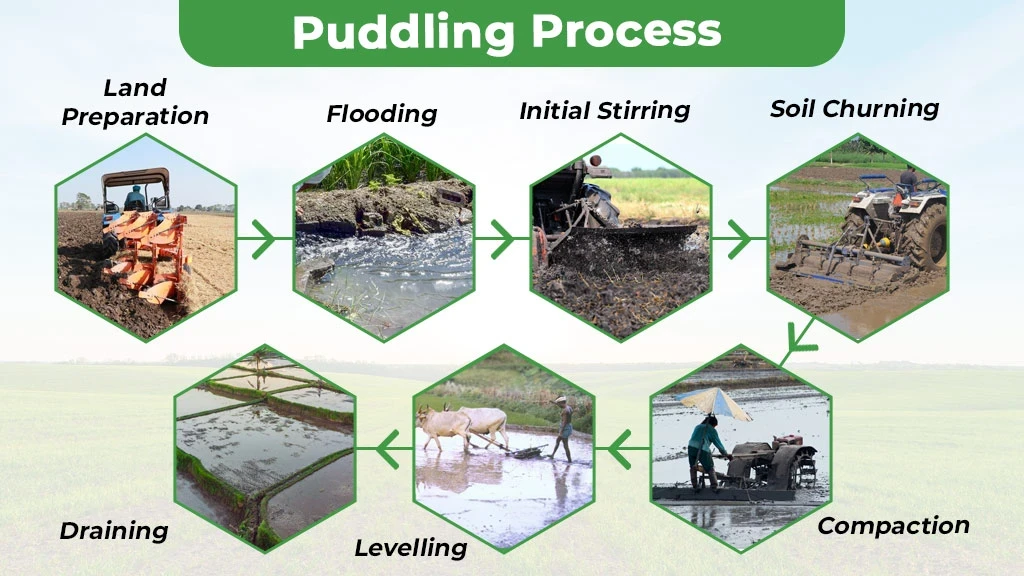
- Land Preparation, the crucial first step of puddling, begins with ploughing and harrowing the land. This initial step is vital as it ensures a smooth, levelled field, setting the foundation for the entire process. The next step is to fill the field with water to make the soil softer and swollen.
- A puddler is used to mix the soil and water appropriately and level the soil. This will break down all the soil particles.
- Further, mix the soil with a puddler in a way that should create a smooth soil-water mixture.
- You need to compact the soil until it creates a dense layer on the surface, so there will be no space for water and air.
- After so many passes with the puddler, level the field's surface to ensure uniform water depth in the various stages of the cultivation.
- Let the water drain out to a particular level to transplant rice/paddy seedlings after completing the puddling process.
Methods of Puddling in India
Different puddling methods are practised in rice farming depending on the farm area, soil type and moisture content. These methods require different farm mechanization implements such as plough and puddler which are the most essential implements in rice farming. Let’s understand the different puddling methods practised in India below:
Manual Puddling
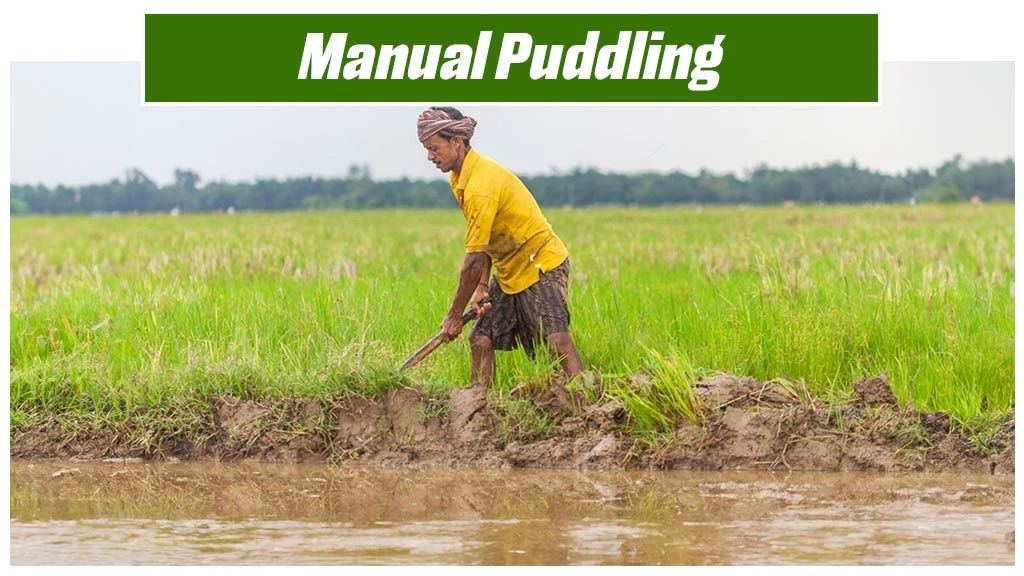
Manual puddling is the traditional method of puddling in rice farming. It can only be done in less space or in a small rice field. It uses a hand spade, which cuts and inverts the soil and makes it soft to get better soil conditions and better rice crops. Farmers who have very small farm areas usually practice this method.
Bullock-Drawn Puddling
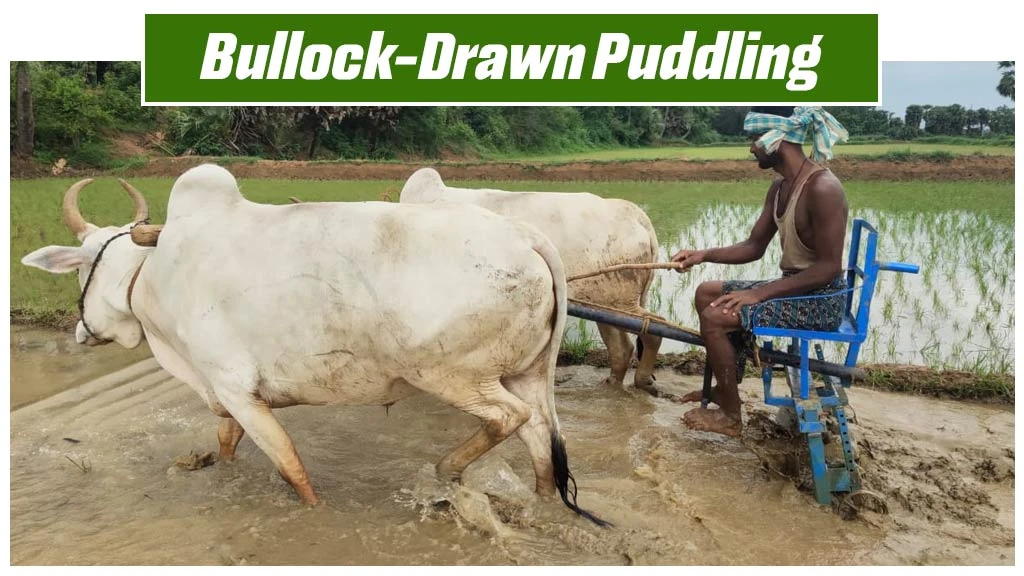
The bullock-drawn method is one of the standard methods of puddling in remote areas. It is practised by the farmers with the use of bullocks and wooden ploughs. It is a traditional method and is a more laborious and time-consuming process.
Power Tiller Operated Puddling

A power tiller is a substitute for animal power and is widely used for puddling in India. It is a 2-wd agricultural implement fitted with rotary tillers. It is also known as a walking tractor. It is quite popular among farmers due to its multipurpose operations, such as ploughing, puddling and levelling. It can cut and reverse soil simultaneously. In hilly regions, where only terrace farming can be done, power tiller-operated puddling can be the best choice for farmers. So, farmers with less farm space can buy the power tiller machine for rice cultivation.
Tractor-Drawn Puddling
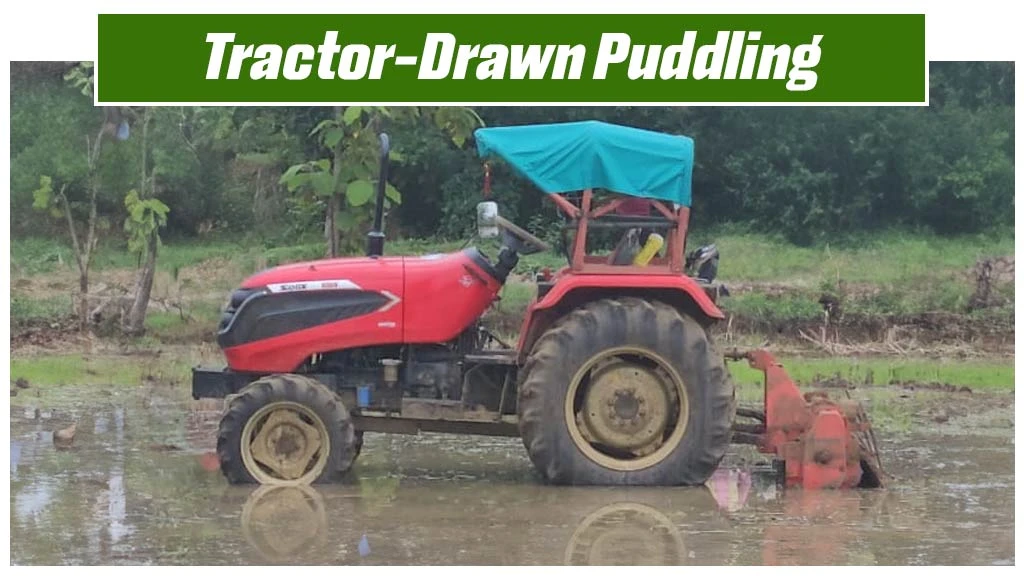
Tractor-drawn puddling is the most popular and easy method, which gives faster results when compared to the above-defined methods. Puddling is done using both 2WD and 4WD tractors. But make sure to consider some factors while choosing a tractor for your rice farming such as:
- The tractor should be of a minimum of 30 HP. We recommend you to buy a minimum of 40 HP tractor for the better performance.
- It should have a sealed axle to work in water-logged conditions.
- The weight of the tractor should be less so that there will be less soil compaction which results in better crop production.
- The tractor should have a low turning radius to work efficiently in small paddy fields.
Now, let’s have a look on the 2WD and 4WD tractors used in puddling.
For 2WD tractors, you have to use the cage wheels. These are sturdy cage wheels helps to blend the soil in wet land conditions. It is more time-consuming process when compared to 4WD tractors. It is such a difficult task to assemble and dissemble the cage wheel when working with 2WD tractors for puddling.
Whereas, the 4WD tractor-drawn puddling can be done without the use of cage wheels. This method is more preferable as only a implement attachment is required. The 4WD tractors distribute equal power to all wheels so it reduces the slippage issues in the sticky and muddy paddy fields. These tractors have comparatively low turning radius which is an essential factor to be consider in the process of puddling. So overall, the use of 4WD tractors in puddling are more time saving process and gives better crop productivity.
Choose your tractor according to the soil conditions and the paddy field. You can also check out our Top 10 puddling special tractors blog on Tractorkarvan for better decision.
Frequently Asked Questions On A Comprehensive Guide on Puddling in Rice Farming:
1. What is puddling in paddy field?
Puddling is the tillage method in which soil is ploughed by a puddler in standing water of 5-10 cm depth to prepare seedbed for the cultivation of rice.
2. What is the main objective of puddling in paddy?
The objective of puddling is to churn the soil with water and soften the soil to prepare a soft seedbed for the cultivation of rice and to get a better rice crop.
3. What are the advantages of puddlers?
The puddler is a specialised rotavator used to blend and level the soil in a single pass which is the most important benefit of the puddler.
4. What are the methods of puddling in agriculture?
There are various methods of puddling such as manual puddling, bullock-drawn puddling, power tiller operated puddling and tractor-drawn puddling.
5. What is the difference between a rotavator and a puddler?
A rotavator is a farm implement used to cut, mixes and levels the soil whereas a puddler is a specialised rotavator having J-shaped blades used to detangle the soil clumps in the field.


Related Blogs

